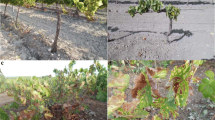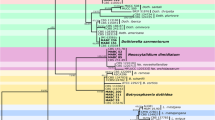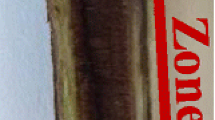Abstract
Production of table grapes is a major export commodity in the region of Piura, one of the most important grape-production areas of Peru. Characteristic symptoms of Botryosphaeria dieback were observed in vineyards throughout this region. The aim of this study was to characterise the symptoms of dieback of table grapes; evaluate the incidence and prevalence of the disease; identify the aetiological agent and evaluate its pathogenicity and virulence. The disease was present in all vineyards surveyed but incidence varied with location. A botryosphaeriaceous fungus was isolated from symptomatic plants collected in five different vineyards in Piura. On the basis of morphological and cultural characters as well as phylogenetic analysis of the internal transcribed spacer region (ITS), and part of the translation elongation factor 1-α gene (EF1-α) the isolates were identified as belonging to the species Lasiodiplodia theobromae. Inoculation of cv. Red Globe plants confirmed the pathogenicity of the isolates and revealed differences in virulence among the isolates tested. This is the first report of L. theobromae as causal agent of dieback of table grapes in Peru, which represents a threat to Peruvian vineyards productivity and longevity.






Similar content being viewed by others

References
Akgul, D. S., Savas, N. G., & Eskalen, A. (2014). First report of wood canker caused by Botryosphaeria dothidea, Diplodia seriata, Neofusicoccum parvum, and Lasiodiplodia theobromae on grapevine in Turkey. Plant Disease, 98(4), 568.
Alama, I., Maldonado, E., & Rodríguez Gálvez, E. (2006). Lasiodiplodia theobromae afectando el Cultivo de Palto (Persea americana) en las condiciones de Piura-Perú. Universalia, 11(2), 4–13.
Al-Saadoon, A. H., Ameen, M. K. M., Hameed, M. A., Al-Badran, A., & Ali, Z. (2012). First report of grapevine dieback caused by Lasiodiplodia theobromae and Neoscytalidium dimidiatum in Basrah, Southern Iraq. African Journal of Biotechnology, 11(95), 16165–16171.
Alves, A., Correia, A., Luque, J., & Phillips, A. J. L. (2004). Botryosphaeria corticola sp. nov. on Quercus species, with notes and description of Botryosphaeria stevensii and its anamorph Diplodia mutila. Mycologia, 96, 598–613.
Alves, A., Phillips, A. J. L., Henriques, I., & Correia, A. (2007). Rapid differentiation of species of Botryosphaeriaceae by PCR fingerprinting. Research in Microbiology, 158, 112–121.
Alves, A., Crous, P. W., Correia, A., & Phillips, A. J. L. (2008). Morphological and molecular data reveal cryptic speciation in Lasiodiplodia theobromae. Fungal Diversity, 28, 1–13.
Amponsah, N. T., Jones, E. E., Ridgway, H. J., & Jaspers, M. V. (2011). Identification, potential inoculum sources and pathogenicity of botryosphaeriaceous species associated with grapevine dieback disease in New Zealand. European Journal of Plant Pathology, 131, 467–482.
Aroca, A., Raposo, R., Gramaje, D., Armengol, J., Martos, S. & Luque, J. (2008). First report of Lasiodiplodia theobromae associated with decline of grapevine rootstock mother plants in Spain. Plant Disease, 92(5), 832.
Baskarathevan, J., Jaspers, M. V., Jones, E. E., & Ridgway, H. J. (2012). Identification, incidence and distribution of botryosphaeriaceous species in New Zealand vineyards. European Journal of Plant Pathology, 132, 549–560.
Bertsch, C., Ramírez-Suero, M., Magnin-Robert, M., Larignon, P., Chong, J., Abou-Mansour, E., Spagnolo, A., Clément, C., & Fontaine, F. (2013). Grapevine trunk diseases: complex and still poorly understood. Plant Pathology, 62(2), 243–265.
Burruano, S., Mondello, V., Conigliaro, G., Alfonzo, A., Spagnolo, A., & Mugnai, L. (2008). Grapevine decline in Italy caused by Lasiodiplodia theobromae. Phytopathologia Mediterranea, 47, 132–136.
Correia, K. C., Câmara, M. P. S., Barbosa, M. A. G., Sales, R., Jr., Agustí-Brisach, C., Gramaje, D., León, M., García-Jiménez, J., Abad-Campos, P., Armengol, J., & Michereff, S. J. (2013). Fungal trunk pathogens associated with table grape decline in Northeastern Brazil. Phytopathologia Mediterranea, 52(2), 380–387.
Damm, U., Crous, P. W., & Fourie, P. H. (2007). Botryosphaeriaceae as potential pathogens of Prunus species in South Africa, with descriptions of Diplodia africana and Lasiodiplodia plurivora sp. nov. Mycologia, 99, 664–680.
El-Goorani, M. A., & El Meleigi, M. A. (1972). Dieback of grapevine by Botryodiplodia theobromae Pat. in Egypt. Phytophatologia Mediterranean, 11, 210–211.
Icochea, T., Perez, W., & Torres, H. (1995). First report of black rot of Oxalis tuberosa tubers caused by Lasiodiplodia theobromae. Plant Disease, 79, 425.
Kaiser, W. J., Rivero, V. G. M., & Valverde, B. E. (2009). First report of diplodia cane dieback of grapevine in Bolivia. Plant Disease, 93(3), 320.
Luque, J., Martos, S., Aroca, A., Raposo, R., & Garcia-Figueres, F. (2009). Symptoms and fungi associated with declining mature grapevine plants in northeast Spain. Journal of Plant Pathology, 91, 381–390.
Martin, M. T., Martin, L., de Francisco, M. T., & Cobos, R. (2009). First report of Lasidiplodia theobromae and Cryptovalsa ampelina associated with grapevine decline from Castilla y León, Spain. Plant Disease, 93(5), 545.
Netto, M. S. B., Assunção, I. P., Lima, G. S. A., Marques, M. W., Lima, W. G., Monteiro, J. H. A., Balbino, V. Q., Michereff, S. J., Phillips, A. J. L. & Câmara, M. P. S. (2014). Species of Lasiodiplodia associated with papaya stem-end rot in Brazil. Fungal Diversity.
Page, R. D. (1996). TreeView: An application to display phylogenetic trees on personal computers. Computer Applications in the Biosciences, 12, 357–358.
Phillips, A. J. L. (2002). Botryosphaeria species associated with diseases of grapevines in Portugal. Phytopathologia Mediterranea, 41, 3–18.
Phillips, A. J. L., Crous, P. W., & Alves, A. (2007). Diplodia seriata, the anamorph of “Botryosphaeria” obtusa. Fungal Diversity, 25, 141–155.
Phillips, A. J. L., Alves, A., Abdollahzadeh, J., Slippers, B., Wingfield, M. J., Groenewald, J. Z., & Crous, P. W. (2013). The Botryosphaeriaceae: Genera and species known from culture. Studies in Mycology, 76, 51–167.
Pitt, W. M., Huang, R., Steel, C. C., & Savocchia, S. (2013). Pathogenicity and epidemiology of Botryosphaeriaceae species isolated from grapevines in Australia. Australasian Plant Pathology, 42(5), 573–582.
Punithalingam, E. (1980). Plant diseases attributed to Botryodiplodia theobromae. In: Biblioteca Mycologica. J. Cramer, Berlin.
Qiu, Y., Steel, C. C., Ash, G. J., & Savocchia, S. (2011). Survey of Botryosphaeriaceae associated with grapevine decline in the hunter valley and mudgee grape growing regions of New South Wales. Australasian Plant Pathology, 40, 1–11.
Rodriguez, F., Oliver, J. F., Marin, A., & Medina, J. R. (1990). The general stochastic model of nucleotide substitutions. Journal of Theoretical Biology, 142, 485–501.
Rodríguez-Gálvez, E., Maldonado, D. E., & Díaz, M. A. (1999). Incidencia de la muerte apical descendente del mango causada por Lasiodiplodia theobromae en Piura, Peru. Fitopatología, 34(2), 90–95.
Savocchia, S., Steel, C. C., Stodard, B. J., & Somers, A. (2007). Pathogenicity of Botryosphaeria species isolated from declining grapevines in sub tropical regions of Eastern Australia. Vitis, 46, 27–32.
Swofford, D. L. (2003). PAUP*. Phylogenetic analysis using parsimony (*and other methods). Version 4.0. Sunderland: Sinauer Associates.
Tamura, K., Stecher, G., Peterson, D., Filipski, A., & Kumar, S. (2013). MEGA6: Molecular evolutionary genetics analysis version 6.0. Molecular Biology and Evolution, 30, 2725–2729.
Taylor, A., Hardy, G. E., St, J., Wood, P., & Burgess, T. (2005). Identification and pathogenicity of Botryosphaeria species associated with grapevine decline in Western Australia. Australasian Plant Pathology, 34, 187–195.
Teng, P. S. and James, W. C. 2001.Disease and yield loss assessment. In: Waller, J.M., Lenné, J.M. and Waller, S.J. Plant Pathologist’s pocketbook. CABI Publishing. Wallingford. Oxon, UK.516 p.
Thompson, J. D., Gibson, T. J., Plewniak, F., Jeanmougin, F., & Higgins, D. G. (1997). The ClustalX windows interface: Flexible strategies for multiple sequence alignment aided by quality analysis tools. Nucleic Acids Research, 25, 4876–4882.
Úrbez-Torres, J. R. (2011). The status of Botryosphaeriaceae species infecting grapevines. Phytopathologia Mediterranea, 50(Suppl), 5–45.
Úrbez-Torres, J. R., & Gubler, W. D. (2009). Pathogenicity of Botryosphaeriaceae species isolated from grapevine cankers in California. Plant Disease, 93, 584–592.
Úrbez-Torres, J. R., Leavitt, G. M., Voegel, T. M., & Gubler, W. D. (2006). Identification and distribution of Botryosphaeria spp. associated with grapevine cankers in California. Plant Disease, 90, 1490–1503.
Úrbez-Torres, J. R., Leavitt, G. M., Guerrero, J. C., Guevara, J., & Gubler, W. D. (2008). Identification and pathogenicity of Lasiodiplodia theobromae and Diplodia seriata, the causal agents of bot canker disease of grapevines in Mexico. Plant Disease, 92, 519–529.
Úrbez-Torres, J. R., Peduto, F., & Gubler, W. D. (2010). First report of grapevine cankers caused by Lasiodiplodia crassispora and Neofusicoccum mediterraneum in California. Plant Disease, 94(6), 785.
Úrbez-Torres, J. R., Peduto, F., Striegler, R. K., Urrea-Romero, K. E., Rupe, J. C., Cartwright, R. D., & Gubler, W. D. (2012). Characterization of fungal pathogens associated with grapevine trunk diseases in Arkansas and Missouri. Fungal Diversity, 52(1), 169–189.
van Niekerk, J. M., Crous, P. W., Groenewald, J. Z., Fourie, P. H., & Halleen, F. (2004). DNA phylogeny, morphology and pathogenicity of Botryosphaeria species on grapevines. Mycologia, 96, 781–798.
van Niekerk, J. M., Fourie, P. H., Halleen, F., & Crous, P. W. (2006). Botryosphaeria spp. as grapevine trunk disease pathogens. Phytopathologia Mediterranea, 45, S43–S54.
van Niekerk, J. M., Bester, W., Halleen, F., Crous, P. W., & Fourie, P. H. (2010). First report of Lasiodiplodia crassispora as a pathogen of grapevine trunks in South Africa. Plant Disease, 94(8), 1063.
Vivier, M. A., & Pretorius, I. S. (2002). Genetically tailored grapevines for the wine industry. Trends in Biotechnology, 20, 472–478.
Webb, R. & Fernández B.G. (2013). Anuario Estadístico El Perú en Números. Ed. Tarea Asociación Gráfica Educativa. Lima, Perú. 1271 pp.
Yan, J.-Y., Xie, Y., Zhang, W., Wang, Y., Liu, J.-K., Hyde, K. D., Seem, R. C., Zhang, G.-Z., Wang, Z.-Y., Yao, S.-W., Bai, X.-J., Dissanayake, A. J., Peng, Y.-L., & Li, X.-H. (2013). Species of Botryosphaeriaceae involved in grapevine dieback in China. Fungal Diversity, 61(1), 221–236.
Acknowledgments
This work was partially financed by Instituto de Investigación para el Desarrollo (IIPD) de la Universidad Nacional de Piura, through the FEDU (fondo de investigación universitaria), by European Funds through COMPETE and by National Funds through the Portuguese Foundation for Science and Technology (FCT) within projects PTDC/AGR-FOR/3807/2012 - FCOMP-01-0124-FEDER-027979 and PEst-C/MAR/LA0017/2013. We thank two anonymous reviewers for some valuable comments on a draft of this paper.
Author information
Authors and Affiliations
Corresponding author
Rights and permissions
About this article
Cite this article
Rodríguez-Gálvez, E., Maldonado, E. & Alves, A. Identification and pathogenicity of Lasiodiplodia theobromae causing dieback of table grapes in Peru. Eur J Plant Pathol 141, 477–489 (2015). https://doi.org/10.1007/s10658-014-0557-8
Accepted:
Published:
Issue Date:
DOI: https://doi.org/10.1007/s10658-014-0557-8



